
All About Famous In bundibundi Festivals 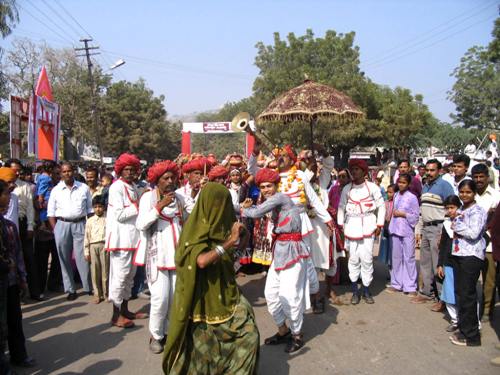 The bundi Festival is being organised for the last five years in bundi, a town in Rajasthan. The festival attracts a large number of foreign tourists who throng the city to witness the various unique programmes organised during the two-day festival. The various events include big colourful procession of camels and bullock carts, carrying people dressed in their traditional attires and the Deep Daan, the flux of lamps at the famous Jaitsagar Lake.
The bundi Festival is being organised for the last five years in bundi, a town in Rajasthan. The festival attracts a large number of foreign tourists who throng the city to witness the various unique programmes organised during the two-day festival. The various events include big colourful procession of camels and bullock carts, carrying people dressed in their traditional attires and the Deep Daan, the flux of lamps at the famous Jaitsagar Lake.
Tejaji Fair (Dugar)(Sept - Oct.) This fair is dedicated to the folk deity Tejaji, large number of people gather here to take bamboo for their village Tejaji temple. This fair continues for five days. bundi Utsav 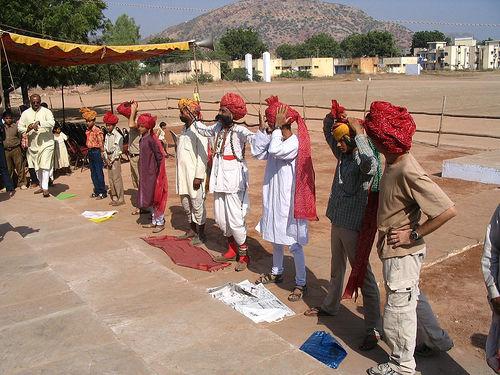 bundi is one of the most picturesque and astonishing spots sited in the Hadoti region in Rajasthan. The bundi Utsav, held annually in the month of November here, has added to the glory of the place and has provided a worldwide exposure. The function is a spellbinding representation of the culture, folklore, traditions and craft of the region. Some of the most renowned artistes from across the country come to perform and create a gripping atmosphere at the venue. The bundi Utsav allures visitors not only from India but also from overseas who come to witness the splendid heritage of the country.
The bundi Utsav begins with a vibrant Shobha Yatra (procession) and features arts & crafts fair, ethnic sports, cultural exhibition and folk /classical music & dance programme to entertain the discerning guests. It also features Deep Daan, sight seeing, traditional rural sports, turban competition, bridal attire, musical band competition and dazzling fireworks display, which attract a huge number of visitors and villagers from nearby regions.
During bundi Utsav, Keshorai Patan, a small town close to bundi, epitomizes the glance of Mini Pushkar in the silver embrace of moonlit night. The villagers, elegantly dressed in their traditional attire, gather at the serene banks of Chambal River. Women chant ritual songs, offer prayers and float lighted lamps into the river, creating a mesmerizing environment. bundi Utsav offers a great opportunity to get a glimpse of appealing tradition & culture of Rajasthan and explore the magic of the Hadoti region.
bundi is one of the most picturesque and astonishing spots sited in the Hadoti region in Rajasthan. The bundi Utsav, held annually in the month of November here, has added to the glory of the place and has provided a worldwide exposure. The function is a spellbinding representation of the culture, folklore, traditions and craft of the region. Some of the most renowned artistes from across the country come to perform and create a gripping atmosphere at the venue. The bundi Utsav allures visitors not only from India but also from overseas who come to witness the splendid heritage of the country.
The bundi Utsav begins with a vibrant Shobha Yatra (procession) and features arts & crafts fair, ethnic sports, cultural exhibition and folk /classical music & dance programme to entertain the discerning guests. It also features Deep Daan, sight seeing, traditional rural sports, turban competition, bridal attire, musical band competition and dazzling fireworks display, which attract a huge number of visitors and villagers from nearby regions.
During bundi Utsav, Keshorai Patan, a small town close to bundi, epitomizes the glance of Mini Pushkar in the silver embrace of moonlit night. The villagers, elegantly dressed in their traditional attire, gather at the serene banks of Chambal River. Women chant ritual songs, offer prayers and float lighted lamps into the river, creating a mesmerizing environment. bundi Utsav offers a great opportunity to get a glimpse of appealing tradition & culture of Rajasthan and explore the magic of the Hadoti region.Organizer Rajasthan Tourism Development Corporation, Jaipur, India Keshav Rai Patan Fair (Oct.- Nov) 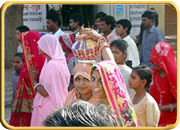 The celebrations start on Kartik Poornima and continues for ten days. Large number of devotees gather overhere to take a holy dip in the river chambal and pray to God Keshav Rai Ji.
The celebrations start on Kartik Poornima and continues for ten days. Large number of devotees gather overhere to take a holy dip in the river chambal and pray to God Keshav Rai Ji. Kajli Teej (July - Aug) The celebration of Kajli Teej in bundi is different from the Teej festival celebrated elsewhere in the state. At other places Teej is celebrated on the third day of the month of Sravana but in bundi it is celebrated on the third day of the month of Bhadra. The festival starts with the procession of Teej in a decorated palanquin from picturesque Naval Sagar and passes through the market culminating at Azad Park. Cultural programs are organized in the evening in which local artists and those from Hadoti region perform. Though the Teej procession is carried out only on two days, celebrations continue up to the 8th day culminating on Janmashtami, birthday of Lord Krishna. Kajli Teej Festival 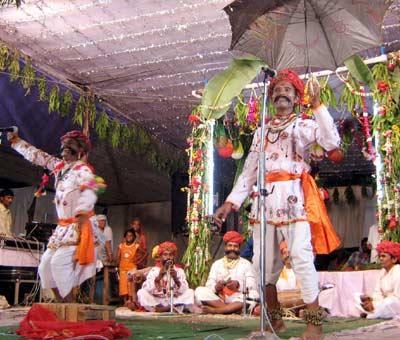 It does not amount to a hyperbolic statement if we say that Rajasthan is the most colorful Indian state. And this very fact can well be established taking a look at the ways different fairs and festivals are celebrated. There are some region-specific celebrations. However this never means that these can not be celebrated in other parts of the state. These are observed in other parts as well but each enjoys a unique feature. Like the festivities of the Kajli Teej are not delimited to bundi only. It is hosted in other parts of the region too. But the way Kajli Teej Festival is observed it attracts huge number of tourists and absolutely intrigue them.
It does not amount to a hyperbolic statement if we say that Rajasthan is the most colorful Indian state. And this very fact can well be established taking a look at the ways different fairs and festivals are celebrated. There are some region-specific celebrations. However this never means that these can not be celebrated in other parts of the state. These are observed in other parts as well but each enjoys a unique feature. Like the festivities of the Kajli Teej are not delimited to bundi only. It is hosted in other parts of the region too. But the way Kajli Teej Festival is observed it attracts huge number of tourists and absolutely intrigue them. The festivities of the Kajli Teej in bundi have its own features. The celebrations of this event begin in the monsoon season spanning from July to August. In other parts of the state this festival takes place on the third day of the month of Shravana. But in bundi it starts on the third day of the month of Bhadra. In Kajli Teej in bundi a huge procession of goddess Teej is carried out. A fully bedecked palanquin is taken out from the stunning Naval Sagar. Covering key bazaars, the parade stops at Azad Park. Caparisoned elephants, camels, bands, performing artists and people attired in striking clothes; all take part in this fair. For married couples the celebrations of bundi's Kajli Teej mean strengthening their fidelity ties. They bask in the festivities related to this fair with savoring special sweetmeats and going for swing rides. Besides, for the tourists the most exciting part is that along with watching cultural programs they can take part in those. Mostly the cultural programs are organized in the evenings. Another interesting part of the cultural programs is the performances by local artists from Hadoti region. The main function of the Kajli Teej Festival continues for 2 days. However the celebrations last till Janmashtami, the birthday of Lord Krishna. MAIN FESTIVALS OF bundi Tejaji Fair( Sept.-Oct.), Keshav Rai Patan Fair ( Nov.) Kajali Teej ( August) Ghas Bheru Festival(Oct.- Nov.) bundi Festival Nov. 2010 Garh palace 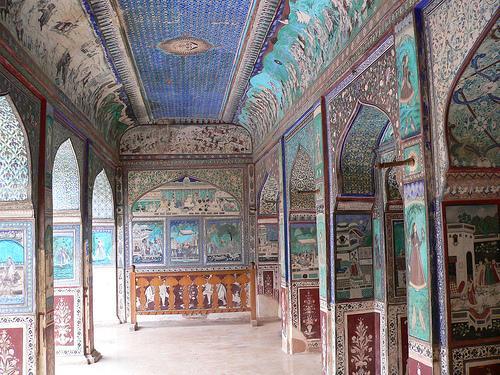 Garh palace is one which has a number of small palaces built around the main royal residence by various rulers over the centuries. Built on terraces on a small hill, portions of the palace now lie in ruins, but parts of it still retain their majestic splendour amidst overgrown grass. A wall surrounds the palace complex, making it seem more like a fort than a place of leisure. The construction of Garh palace was begun by Rao Balwant Singh in 1580.Garh palace
has a cadaverous history, and the most famous among them is that of Hada Rani. Legend says that she was a newly wed bride whose husband was going to battle. Hada Rani's husband didn't want to leave her and so he came back from the outskirts of the battlefield. When she heard of his return, she was filled with disgust, for a true Rajput never leaves the scene of a battle until victory or death is his. Hada Rani chopped off her head, and it was sent to her husband as he entered the gates of the palace.
Garh palace is one which has a number of small palaces built around the main royal residence by various rulers over the centuries. Built on terraces on a small hill, portions of the palace now lie in ruins, but parts of it still retain their majestic splendour amidst overgrown grass. A wall surrounds the palace complex, making it seem more like a fort than a place of leisure. The construction of Garh palace was begun by Rao Balwant Singh in 1580.Garh palace
has a cadaverous history, and the most famous among them is that of Hada Rani. Legend says that she was a newly wed bride whose husband was going to battle. Hada Rani's husband didn't want to leave her and so he came back from the outskirts of the battlefield. When she heard of his return, she was filled with disgust, for a true Rajput never leaves the scene of a battle until victory or death is his. Hada Rani chopped off her head, and it was sent to her husband as he entered the gates of the palace.Gates Two huge gates at the end of a steep climb form the entrance to the Garh palace. The Hazari Pol (Gate of One Thousand) is the first towering gate. Two trumpeting elephants form an arch over the second gate, Hathi Pol (Elephant Gate), built by Rao Ratan Singh (1607-31). The elephants were probably originally cast in brass, but were later replaced by concrete ones painted in bright colours. The Hathi Pol leads into a courtyard beyond which is an arched facade for stables. Chatar Mahal 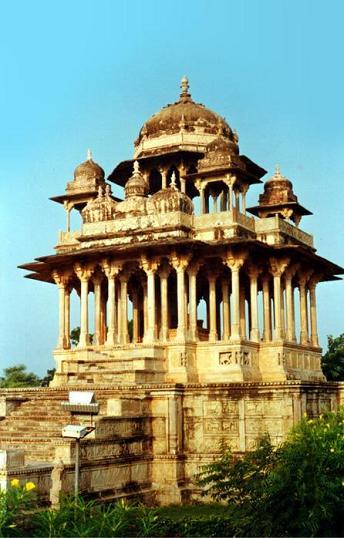 Amongst all the palaces within this complex, the Chatar Mahal is perhaps the finest. Built in 1660 under the directions of Chatar Sal, the palace is a strong example of the Rajput�s independence from Mughal authority, although he was their ally. He was also the only Rajput to be made the Governor of Delhi, a very powerful office. Chatar Sal proved his loyalty to Shah Jahan in the Deccan in the seige of Daulatabad and later fighting the usurper prince Aurangzeb in 1659, a battle in which the mighty Rajput died.
However, his fondness for Mughal alliance did not interfere while he planned Chatar Mahal. Disregarding red sandstone which was the Mughal favourite, Chatar Sal chose stone from bundi�s own quarries. The palace was built in true Rajput finery with elephant motifs, pavilions, curved roofs and small chattris.
Amongst all the palaces within this complex, the Chatar Mahal is perhaps the finest. Built in 1660 under the directions of Chatar Sal, the palace is a strong example of the Rajput�s independence from Mughal authority, although he was their ally. He was also the only Rajput to be made the Governor of Delhi, a very powerful office. Chatar Sal proved his loyalty to Shah Jahan in the Deccan in the seige of Daulatabad and later fighting the usurper prince Aurangzeb in 1659, a battle in which the mighty Rajput died.
However, his fondness for Mughal alliance did not interfere while he planned Chatar Mahal. Disregarding red sandstone which was the Mughal favourite, Chatar Sal chose stone from bundi�s own quarries. The palace was built in true Rajput finery with elephant motifs, pavilions, curved roofs and small chattris. Hathi Shala The Hathi Shala towards the west of Chatar Mahal consists of a number of columns and is so named because of the elephants on each of these pillars. The Hathi Shala leads into smaller chambers where Chatar Sal lived. The long chamber too has elephant motifs on its walls and pillars while two smaller rooms at the back are richly decorated with murals depicting bundi life in the 17th century. Also built by Ratan Singh, the Diwan-e-Am (Hall of Public Audience) is a large canopied pavilion with a white marble throne for the king to cast a discerning eye on his subjects in the courtyard beneath. Ismail Quili Khan's gate aka Buland Darwaza (Great Gate) ies at the foot of the hill and forms the entrance to Miran Hussain's tomb. Looming high over the mausoleum, the gateway is 19.5 meters high and 5 meters wide, a splendid illustration of proportion gone haywire. The gateway was originally built in red sandstone, but somebody decided that it would look better in white, so the gate was whitewashed. On each corner of the roof are two chattris or covered pavilions, and along the sides of the high arch are inscribed verses from the Koran. Sukh Mahal 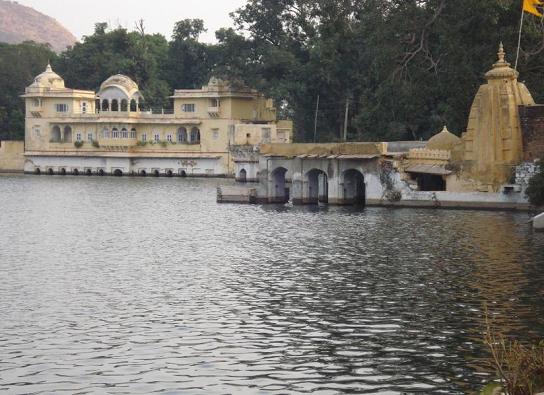 During the 17th and 18 centuries, the banks of the Sukh Sagar (aka Jait Sagar) lake were the hot spot for princes and their entourage to descend upon for days and nights of revelry. In 1773 during Umed Singh's reign a palace was built on the embankment of the lake for princes to engage in debauchery away from the prying eyes of the Rao. The Sukh Mahal (Palace of Bliss) was the venue of precisely such activities, and the secluded environment certainly helped. Near the palace are the hilly jungles where rulers of bundi and Mewar would meet for the annual Aheria boar hunt. While the Sukh Mahal was functional it had tunnels leading right into Garh palace where the Rao resided, just in case something went wrong and flight was necessary. The tunnels are now lost despite attempts to find them.
During the 17th and 18 centuries, the banks of the Sukh Sagar (aka Jait Sagar) lake were the hot spot for princes and their entourage to descend upon for days and nights of revelry. In 1773 during Umed Singh's reign a palace was built on the embankment of the lake for princes to engage in debauchery away from the prying eyes of the Rao. The Sukh Mahal (Palace of Bliss) was the venue of precisely such activities, and the secluded environment certainly helped. Near the palace are the hilly jungles where rulers of bundi and Mewar would meet for the annual Aheria boar hunt. While the Sukh Mahal was functional it had tunnels leading right into Garh palace where the Rao resided, just in case something went wrong and flight was necessary. The tunnels are now lost despite attempts to find them.The Sukh Mahal is a white edifice right on the banks of the lake which makes it seems as though its foundations lie within the water. The inevitable white marble chatri (domed pavilion) stands right in the centre of the roof on the second storey, while the ground floor is now semi-submerged Kesar Bagh 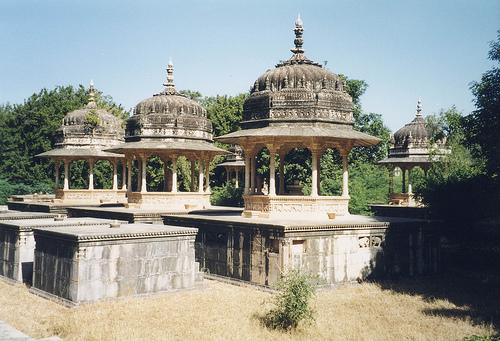 On the opposite side of the Sukh Sagar is Kesar Bagh, a garden created to house cenotaphs of bundi's rulers, their queens and princes. 66 pavilions dot the Kesar Bagh, the first being built in 1581 and the last in 1821. Although the garden is now overgrown with grass and weeds, the pavilions stand out as silent reminders of the lost glory of the bundi Chauhanas. Most of the centopahs are of white marble, their ceilings, pillars and sides delicately carved with motifs of elephants, horses, gods and everyday life. The main chatri is topped with a Shiva linga, a feature commonly seen in most Rajput architecture.
On the opposite side of the Sukh Sagar is Kesar Bagh, a garden created to house cenotaphs of bundi's rulers, their queens and princes. 66 pavilions dot the Kesar Bagh, the first being built in 1581 and the last in 1821. Although the garden is now overgrown with grass and weeds, the pavilions stand out as silent reminders of the lost glory of the bundi Chauhanas. Most of the centopahs are of white marble, their ceilings, pillars and sides delicately carved with motifs of elephants, horses, gods and everyday life. The main chatri is topped with a Shiva linga, a feature commonly seen in most Rajput architecture. |

